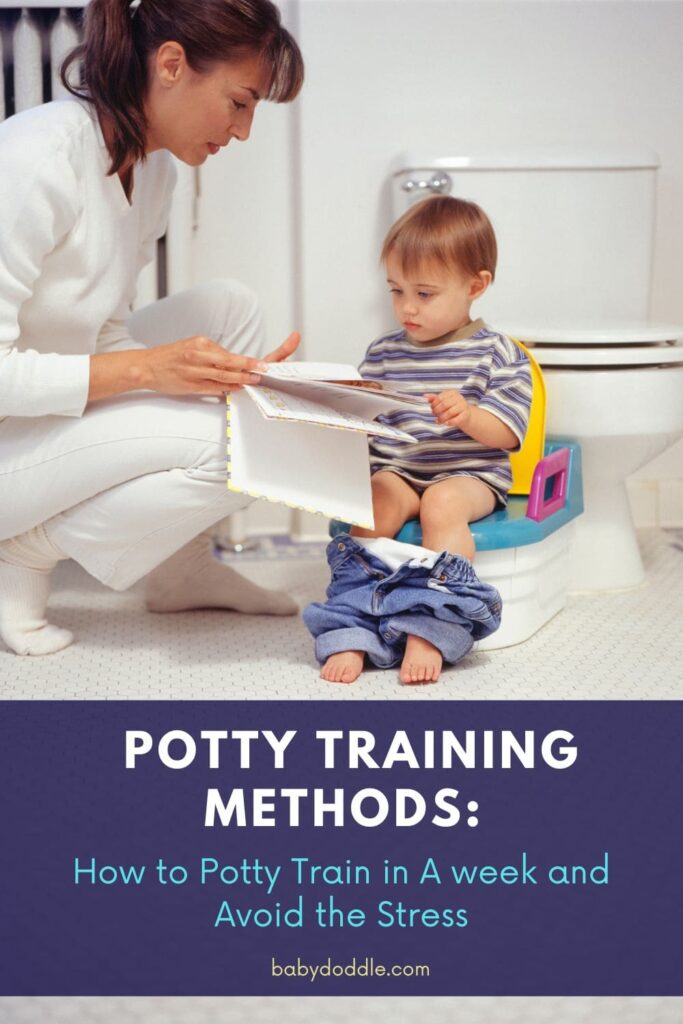Potty training is a major milestone for toddlers, but it’s normal for parents to feel anxious about getting it done quickly without tears, accidents, and frustration. The good news is that with the right potty training methods, you can potty train your little one in just a week or so while keeping stress to a minimum for both of you!
In this post, we’ll go over when to start potty training, how to prepare, and a day-by-day guide to potty training in a week. You’ll also find troubleshooting tips for handling setbacks gracefully. Let’s get started!
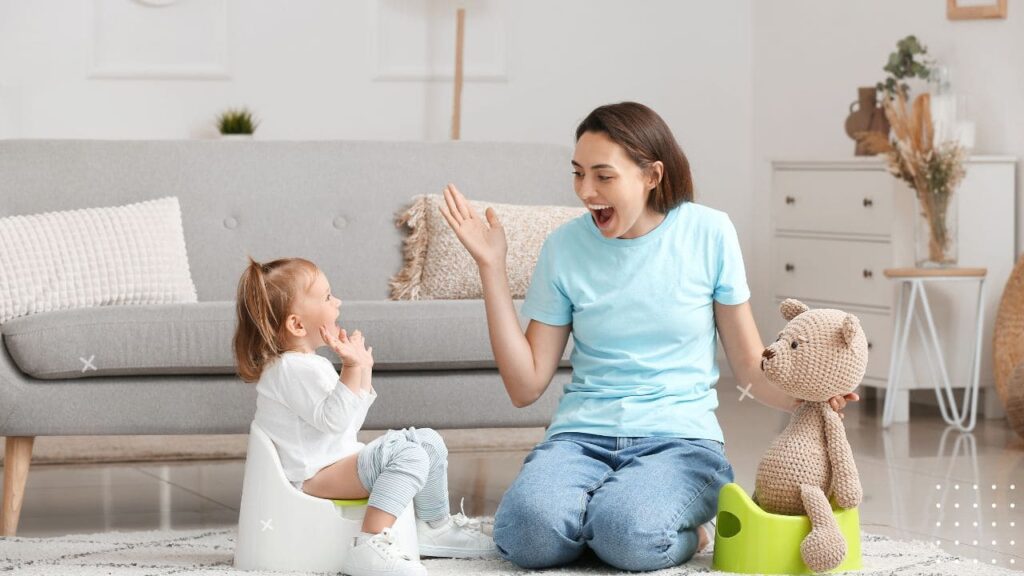
Knowing When Your Toddler is Ready
The first step is understanding when your child is ready for potty training. Starting too early can set you both up for failure while waiting too long can drag out the process longer than necessary.
Signs your toddler is ready include:
- Staying dry for 2-3 hours at a time or after naps
- Communicating when wet or dirty like pointing, grunting, or saying “poop”
- Showing interest in the potty and wanting to wear “big kid” underwear
- Demonstrating independence by indicating when hungry or removing some clothing
- Being able to follow simple instructions
Many experts recommend starting between 18-24 months, but every child is different. Use the readiness signs as a guide, not an absolute timeline.
Preparing for a Successful Potty Training Week
Once you decide to take the potty training plunge, make sure you’re fully prepared and have reasonable expectations. Remind yourself that accidents will happen!
- Get supplies – child-sized potty, step stool, wipes, training pants, etc.
- Let your child pick out fun, character-themed training pants. This builds interest and excitement.
- Make the potty inviting and accessible – place it in your family bathroom or another convenient, frequently-used room.
- Consider using potty training books and videos to familiarize your child with the process. Daniel Tiger has great potty training episodes and songs!
- Have your child sit on the potty while clothed to get them used to the feeling. You can even read books together while sitting on the potty.
Pro tip: Avoid over-prompting or forcing them to sit for more than a few minutes. You don’t want to start a power struggle. Keep it light and positive!
By laying the groundwork during the preparation stage, you’ll set yourself up for a smooth potty training week once you dive in.
| Gear | Consumables | Fun Extras |
|---|---|---|
| Potty chair & step stool | Training pants | Potty books & videos |
| Wipes or spray bottle | Stickers & rewards | Bathroom toys |
| Soft-absorbency training pants | Hand soap & paper towels | Potty party supplies |
| Waterproof pads & mattress covers | Cleaning products | Potty training dolls |
| Portable potty seat | Flushable wipes | Character underwear |
| Extra clothes | Disposable bags | Custom potty chart |
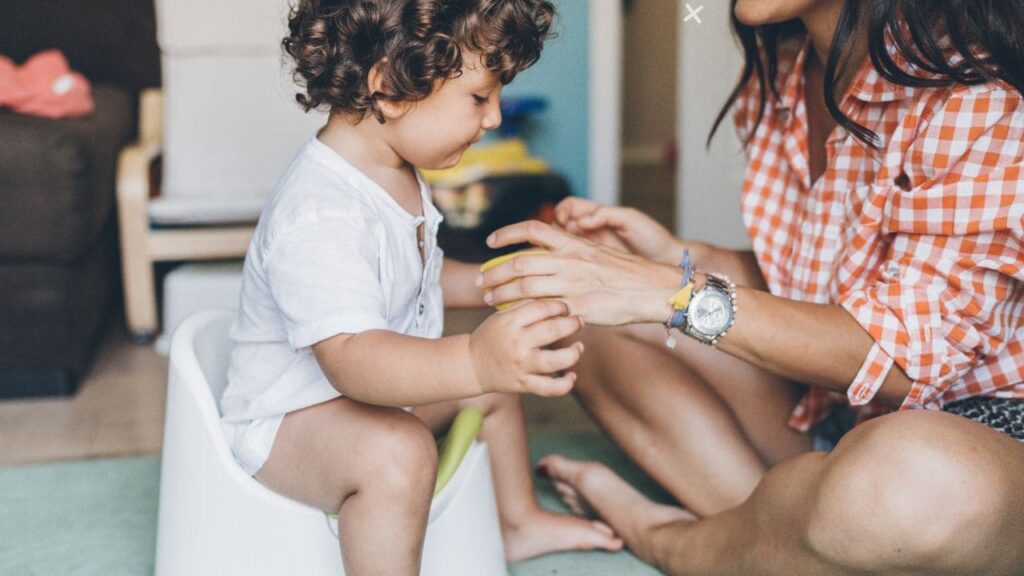
Potty Training Day-by-Day Guide
Now let’s walk through the day-by-day approach to potty train your toddler in a week or less! Having a plan and checklist for each day will keep you on track.
Day 1: Build Excitement and Introduce the Potty
- Hype up how your child is becoming a “big kid” and gets to use their cool new potty
- Let them sit on the potty while clothed and while you’re also “using” the potty so they learn to imitate
- Offer rewards like a special treat or sticker for just trying to sit on the potty
Don’t worry about actual pee or poop in the potty yet – today is just about getting comfortable with the potty itself. Praise any interest your child shows in their potty seat, any curiosity about bathroom habits, etc. You’re building an association of the potty with positivity.
Day 2: Connect Potty Time with Routine
- Put your toddler in training pants or underwear (no diapers, except for naps/bedtime!)
- Set a reminder to take your child to the potty every 30-60 minutes. Use a fun timer or song.
- Also prompt potty use when your child shows “pee/poop signals” like holding themselves, grunting, or squatting.
- Offer lots of praise and maybe a small reward just for trying to go potty. Don’t require actual success yet.
- Add potty time to your morning routine (before/after breakfast), afternoon routine (before/after nap), and evening routine (before bed).
Tip: If accidents happen, remain calm. Remind your child that next time they should try to go potty. Avoid any anger or shaming – remember this is a learning process!
Day 3: Support Independent Potty Use
- Put your toddler in underwear or training pants again. Try going diaper-free for increasing amounts of nap time.
- Back off the reminders a bit – wait for your child to say they need to go potty, or for obvious “pee/poop” signals.
- If they indicate need to go, quickly guide them to the potty and help/praise them for using it.
- Give an immediate reward like a fun sticker as soon as they finish using the potty successfully. Sticker charts are great motivation!
Don’t worry if your child has more accidents today without the constant reminders. The goal now is to help them recognize on their own when they need to go potty. The stickers will start incentivizing this self-awareness.
Day 4: Confidence Building and Practice
- Put child in underwear/training pants and send any remaining diapers to daycare or the trash!
- Add “dry checks” before leaving the house, after naps and at bedtime.
- Continue sticker rewards for responsible potty use, both prompted and unprompted trips.
- If comfortable, introduce using the “big” toilet with a child seat insert. This helps them feel like a big kid!
- Consider an outing to a kid-friendly public place to practice newly acquired potty skills. Pick somewhere with easily accessible potties.
Some occasional accidents are still normal, so bring a change of clothes when you go out. Praise every success and reassure them that potty training is a learning process if accidents happen.
Day 5: Time for Big Kid Underwear!
- Have your toddler pick out some fun underwear with their favorite characters on it to inspire pride and self-confidence.
- Send the training pants off to daycare or storage – they get to wear underwear all day now!
- Stick with the reward chart for successful potty trips, but you can start phasing out the constant reminders. See if they can go 1-2 hours initiating bathroom time independently.
- Start asking your child to help change their own clothes after an accident. They are becoming a big kid now!
- Consider cutting back on fluids before bed to help stay dry overnight. Sticker chart small rewards for dry mornings too.
Tip: If accidents are happening frequently again, don’t regress back to training pants or diapers. This sends mixed signals. Just go back to regularly prompting trips to the potty until the child regains awareness again.
Day 6: Habit Forming and Consistency
- Keep your child in underwear all day, including outings and visits with family/friends. This builds consistency with potty training in different environments.
- Continue using sticker rewards for successful trips to reinforce the positive potty habit.
- Ask your toddler to help wipe, flush the toilet, wash hands, and assist with changing clothes. Make using the potty from start to finish their job as a big kid!
- Add in some trips to public restrooms instead of just at home. Show them how to pull down their underwear, use the toilet, flush, wash hands, etc. just like Mom or Dad.
- Maintain a consistent daily routine with potty time before/after meals, naps, bedtime and leaving home. Consistency cement habits!
If your child seems resistant to prompts or reminders, try switching up your approach. Have them sit backwards on the toilet like it’s a horse or offer fun potty reading material. Keep it positive!
Day 7: Celebrate Success!
- Send your child to preschool or daycare in their new underwear. Let teachers know about the potty training progress!
- Take a fun family outing like the playground, zoo, or pool to let your toddler show off their potty skills.
- Have a celebratory dinner, dessert, or fun family night to celebrate mastering the potty! They did it!
- Transition to just using standard verbal praise and occasional stickers. The bulk of potty training is complete!
- Still expect the occasional accident as they continue building awareness. But underwear is here to stay!
Tip: Avoid excessive fluids before bed and continue sticker rewards for staying dry at night. Night training may take more time. Use mattress covers and be patient!
Involving Siblings in the Potty Training Process
Having older siblings involved in potty training can help motivate and normalize it for the trainee. Here are some ways to get brothers and sisters onboard:
- Let siblings help decorate the new potty with stickers and drawings
- Have them model potty behavior by letting the trainee come into the bathroom with them
- Siblings can sing fun potty songs together while the trainee sits
- Ask them to give high-fives and participate in celebrations for successes
- Consider a sibling reward chart too for encouraging potty trips
- Let them proudly share their own experiences mastering the potty
- Ensure siblings never shame or scare the trainee over accidents
Getting the whole family involved makes potty training a team effort!
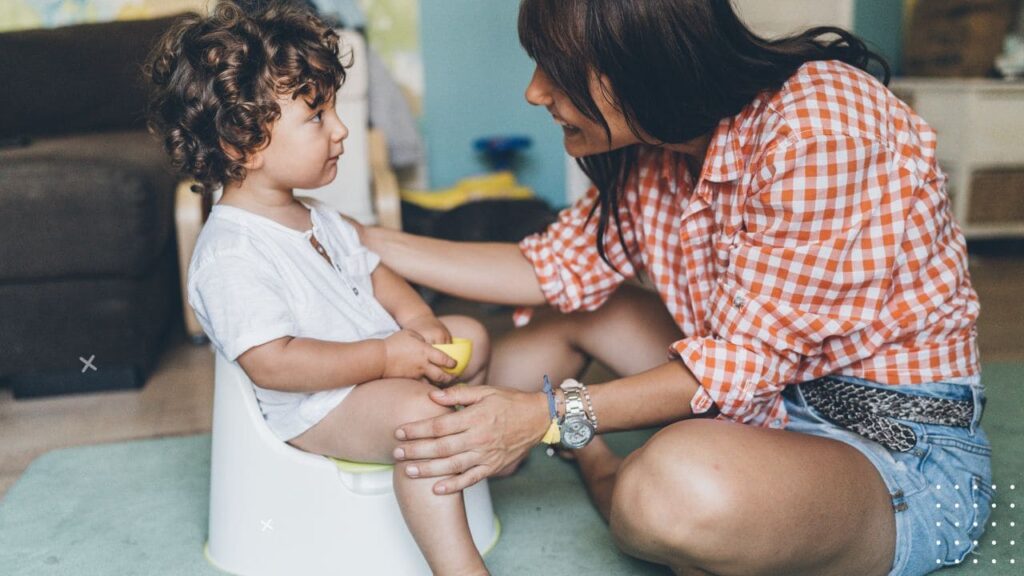
Creative Incentives Beyond Sticker Charts
While sticker rewards are common, you may need some other creative incentives too for reluctant trainees. Here are more ideas:
- Allow screen time with a fun potty training video or app when they use the potty
- Give them a matching stuffed animal or doll that also gets to wear underwear
- Have a dance party celebration for pee or poop successes
- Take them on special big kid outings like museums or bounce houses after milestones
- Create a customized superhero diploma certifying their potty training graduation
- Let them pick small prizes from a goodie bag or treasure chest for achievements
Finding what motivates your specific child is key. Get creative with incentives!
Special Considerations for Twins or Multiples
Potty training twins or higher-order multiples comes with unique challenges:
- Train together for bonding and modelling, but recognize differences
- Use separate potties and reward charts to avoid competition
- Give equal attention and praise – don’t compare progress
- Watch for sabotaging behavior between siblings
- Accept that training may take longer than a week due to distractions
- Prepare for tandem potty trips and accidents
- Coordinate consistency with daycare and caregivers
Be patient and realistic when potty training multiple children at once. Celebrate team and individual successes!
Troubleshooting Setbacks During Potty Training
What if you hit a bump in the road with regressions, resistance or stand-still potty training progress? Here are some troubleshooting tips:
For Accidents:
- Remain calm and reassuring – anxiety can cause more accidents.
- Discreetly change wet clothes without overreacting.
- Use prompts and stickers to re-incentivize
For Resistance to the Potty:
- Make sure the potty chair is comfortable and toddler-sized
- Offer rewards like stickers just for sitting, not just for performance
- Use favorite books, songs, or toys to make it more fun
- Give choices like which potty or training pants to use
For Constipation Issues:
- Ensure diet has enough fiber from fruits/veggies, whole grains
- Offer plenty of fluids and include probiotic foods like yogurt
- Try tummy massages to relax stomach muscles
- Ask pediatrician about child-safe laxatives if needed
For Major Stress or Anger:
- Take a break and reset if needed. Forcing it can backfire.
- Acknowledge and validate their frustrations
- Model deep breaths and praise every little try
- Focus on independence building like pulling down their own pants
For Frequent Accidents After Progress:
- Rule out medical issues like UTI or diabetes
- Revisit initial incentive and prompting techniques
- Adjust fluid intake by limiting before bedtime
- Practice patience and consistency in your approach
For Difficulty Understanding The Process:
- Re-read potty training books and re-watch helpful videos
- Use favorite dolls or stuffed animals to model potty use
- Speak slowly and clearly in simple phrases they understand
- Demonstrate the steps like pulling down pants, sitting, wiping, flushing, etc.
The key is not to revert back to diapers or shame your child. Maintain a calm, consistent and understanding approach. It may take more than a week, but stay the course and celebrate every step! You’ve got this.
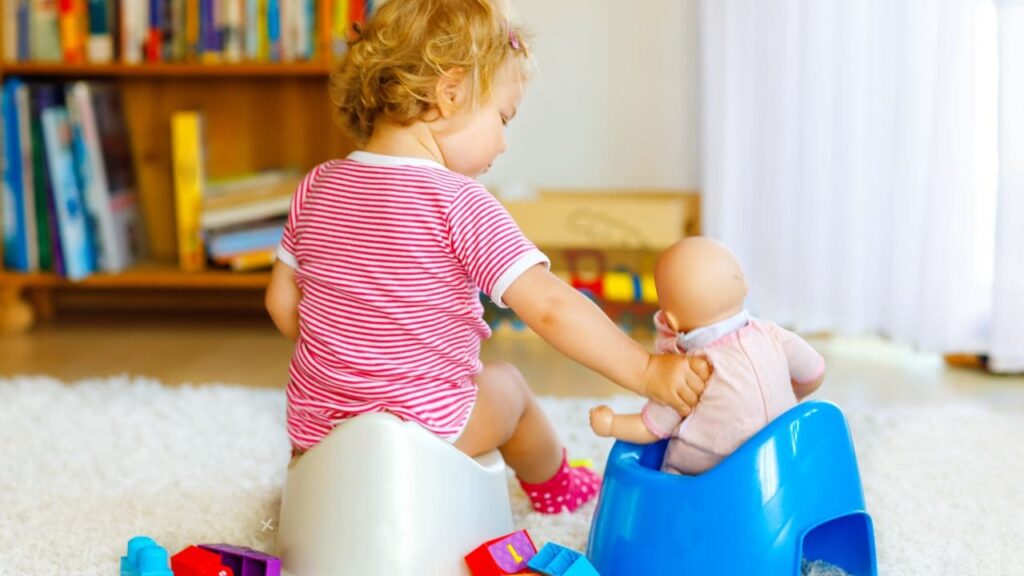
Making Potty Training Progress Last
You did it – your toddler used the potty successfully for a week! But the work isn’t fully over once you pass that 7-day mark. Here are some tips to maintain the progress:
- Continue using sticker charts or small prizes for potty success for several more weeks to reinforce the habit. Then slowly fade them out.
- When going out in public, remind them regularly to let you know if they need to potty. Don’t wait for them to tell you.
- Pack spare clothes and use plastic bags for accidents when out and about. Expect occasional regressions.
- Continue reading engaging potty-themed books together to instill positive bathroom habits.
- Be prepared with a kid-sized portable potty seat or training pants as needed for long outings or trips.
- Talk to daycare providers and preschool teachers so you stay consistent in routines and communication.
- Add reminders and incentives at bedtime to work on nighttime dryness. Consider limiting fluid intake in evenings.
- Respond calmly to accidents and mess. Remind your toddler what their new potty skills are and that mistakes are just part of learning.
Stay patient, flexible and consistent, and your potty trained toddler will continue mastering this big milestone! It may be a messy journey, but the rewards of your child’s independence and pride are so worth it.
More Potty Training Tips and Resources
I hope this guide gave you a helpful overview of how to potty train in just a week! For additional resources, check out:
- Oh Crap Potty Training Book by Jamie Glowacki – hilarious and informative method
- 3 Day Potty Training by Lora Jensen – great accelerated approach
- Daniel Tiger’s Potty Training episodes on PBS – kid-friendly videos!
Remember every child is different, so stay flexible and responsive to your toddler’s signals. With consistency, patience and plenty of praise through the process, you CAN potty train quickly and minimize stressful resistance. Your little one will be out of diapers and going to the bathroom independently in no time!
FAQ – Potty Training Methods
What are some signs my child is ready to start potty training?
Signs of potty training readiness include staying dry for 2-3 hours at a time, waking up dry from naps, communicating the need to go, showing interest in the potty, following simple instructions, displaying independence in dressing themselves, and having the coordination to pull pants up and down. Many experts recommend starting between 18-24 months once you notice these indicators.
How long does potty training take on average?
Most children can complete potty training in 3-6 months, but it depends on the child’s developmental readiness. Using an accelerated method like the one outlined in this post, you may be able to potty train your child in 1 week or less if you catch them at the right window of readiness. But every child is different, so stay flexible.
What should I do if we are struggling with potty training regression?
Accidents and backsliding are common during potty training. To get back on track, rule out medical issues, revisit initial incentive and prompting techniques, limit fluid intake at troublesome times, use absorbent nighttime training pants as needed, and practice patience and consistency. Identify and address the underlying cause, whether it’s a developmental leap, change in routine, stubborness, or other issue. Stay calm and understanding.
How can I make potty training fun and engaging for my toddler?
Incorporate games, songs, videos, stuffed animals modelling potty use, creative incentive charts with stickers or prizes, books, novelty potties that play music, trips to select new character underwear, and celebrations like potty dances or play time as rewards. Let them take ownership by picking out supplies and decorating their potty. Focus on pride, not just performance.
What are some common mistakes parents make when potty training?
Starting too early before signs of readiness, using diapers or pullups instead of real training pants, reacting harshly to accidents, forcing a child to sit on the potty against their will, unrealistic expectations for day and nighttime dryness, punishing regression or not using enough positive reinforcement and consistency can all undermine potty training success. Be responsive, patient, and flexible to get the best results.
